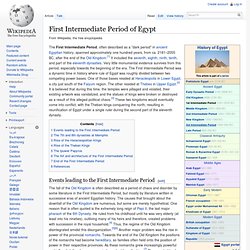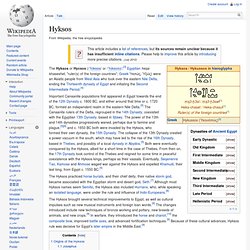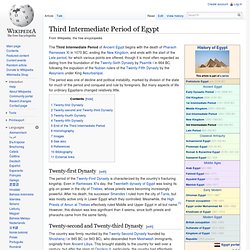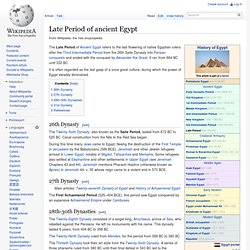

Demographics of Morocco. Morocco. Late Paleolithic Egypt. Ancient Egypt. Early Dynastic Period of Egypt. A plate created during the Early Dynastic period of Ancient Egypt.

It depicts a man on a boat alongside a Hippopotamus and a Crocodile The Archaic or Early Dynastic Period of Egypt immediately follows the unification of Lower and Upper Egypt c. 3100 BC. It is generally taken to include the First and Second Dynasties, lasting from the Protodynastic Period of Egypt until about 2686 BC, or the beginning of the Old Kingdom.[1] With the First Dynasty, the capital moved from Abydos to Memphis with a unified Egypt ruled by an Egyptian god-king.
Abydos remained the major holy land in the south. The hallmarks of ancient Egyptian civilization, such as art, architecture and many aspects of religion, took shape during the Early Dynastic period. Before the unification of Egypt, the land was settled with autonomous villages. Cultural evolution[edit] Concurrent with these cultural advances, a process of unification of the societies and towns of the upper Nile River, or Upper Egypt, occurred. Early Dynastic period of Egypt. Old Kingdom of Egypt. The Old Kingdom is the name given to the period in the 3rd millennium BC when Egypt attained its first continuous peak of civilization – the first of three so-called "Kingdom" periods, which mark the high points of civilization in the lower Nile Valley (the others being Middle Kingdom and the New Kingdom).

The term itself was coined by eighteenth-century historians and the distinction between the Old Kingdom and the Early Dynastic Period is not one which would have been recognized by Ancient Egyptians. Not only was the last king of the Early Dynastic Period related to the first two kings of the Old Kingdom, but the 'capital', the royal residence, remained at Ineb-Hedg, the Ancient Egyptian name for Memphis. The basic justification for a separation between the two periods is the revolutionary change in architecture accompanied by the effects on Egyptian society and economy of large-scale building projects.[1] Third Dynasty[edit] Fourth Dynasty[edit] Fifth Dynasty[edit] Sixth Dynasty[edit]
Old Kingdom of Egypt. First Intermediate Period of Egypt. The First Intermediate Period, often described as a "dark period" in ancient Egyptian history, spanned approximately one hundred years, from ca. 2181–2055 BC, after the end of the Old Kingdom.[1] It included the seventh, eighth, ninth, tenth, and part of the eleventh dynasties.

Very little monumental evidence survives from this period, especially towards the beginning of the era. The First Intermediate Period was a dynamic time in history where rule of Egypt was roughly divided between two competing power bases. One of those bases resided at Heracleopolis in Lower Egypt, a city just south of the Faiyum region. Events leading to the First Intermediate Period[edit] The fall of the Old Kingdom is often described as a period of chaos and disorder by some literature in the First Intermediate Period, but mostly by literature written in successive eras of ancient Egyptian history.
The 7th and 8th dynasties at Memphis[edit] First Intermediate period of Egypt. Middle Kingdom of Egypt. Middle Kingdom of Egypt. Second Intermediate period of Egypt and the Hyksos. Second Intermediate Period of Egypt. Hyksos. The Hyksos or Hycsos (/ˈhɪksɒs/ or /ˈhɪksoʊz/;[3] Egyptian heqa khaseshet, "ruler(s) of the foreign countries"; Greek Ὑκσώς, Ὑξώς) were an Asiatic people from West Asia who took over the eastern Nile Delta, ending the Thirteenth dynasty of Egypt and initiating the Second Intermediate Period.[4] Important Canaanite populations first appeared in Egypt towards the end of the 12th Dynasty c. 1800 BC, and either around that time or c. 1720 BC, formed an independent realm in the eastern Nile Delta.[5] The Canaanite rulers of the Delta, regrouped in the 14th Dynasty, coexisted with the Egyptian 13th Dynasty, based in Itjtawy.

The power of the 13th and 14th dynasties progressively waned, perhaps due to famine and plague,[5][6] and c. 1650 BC both were invaded by the Hyksos, who formed their own dynasty, the 15th Dynasty. New Kingdom of Egypt. The New Kingdom of Egypt, also referred to as the Egyptian Empire, is the period in ancient Egyptian history between the 16th century BC and the 11th century BC, covering the Eighteenth, Nineteenth, and Twentieth Dynasties of Egypt.

Radiocarbon dating places the exact beginning of the New Kingdom between 1570–1544 BC.[1] The New Kingdom followed the Second Intermediate Period and was succeeded by the Third Intermediate Period. It was Egypt’s most prosperous time and marked the peak of its power.[2] The New Kingdom of Egypt. Eighteenth Dynasty. Nineteenth Dynasty. Twentieth Dynasty. Third Intermediate Period of Egypt. Political factions fractured ancient Egypt during the Third Intermediate Period.

The boundaries above show the political situation during the mid-8th century BCE. The Third Intermediate Period of Ancient Egypt begins with the death of Pharaoh Ramesses XI in 1070 BC, ending the New Kingdom, and ends with the start of the Late period, for which various points are offered, though it is most often regarded as dating from the foundation of the Twenty-Sixth Dynasty by Psamtik I in 664 BC, following the expulsion of the Nubian rulers of the Twenty-Fifth Dynasty by the Assyrians under King Assurbanipal. The period was one of decline and political instability, marked by division of the state for much of the period and conquest and rule by foreigners. But many aspects of life for ordinary Egyptians changed relatively little. 25th Dynasty Nuri pyramids Twenty-first Dynasty[edit] Third Intermediate Period of Egypt. Late Period of ancient Egypt. The Late Period of Ancient Egypt refers to the last flowering of native Egyptian rulers after the Third Intermediate Period from the 26th Saite Dynasty into Persian conquests and ended with the conquest by Alexander the Great.

It ran from 664 BC until 332 BC. It is often regarded as the last gasp of a once great culture, during which the power of Egypt steadily diminished. 26th Dynasty[edit] The Twenty-Sixth Dynasty, also known as the Saite Period, lasted from 672 BC to 525 BC. Canal construction from the Nile to the Red Sea began. During this time many Jews came to Egypt, fleeing the destruction of the First Temple in Jerusalem by the Babylonians (586 BCE). 27th Dynasty[edit] The First Achaemenid Period (525–404 BCE), this period saw Egypt conquered by an expansive Achaemenid Empire under Cambyses. 28th-30th Dynasties[edit] The Twenty-Eighth Dynasty consisted of a single king, Amyrtaeus, prince of Sais, who rebelled against the Persians. 31st Dynasty[edit]
The late period of Ancient Egypt.